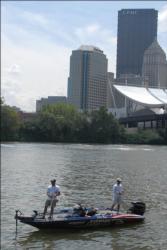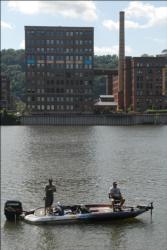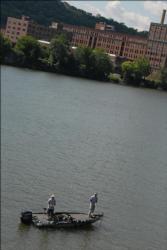Pittsburgh Cup promises to be unique, complex
Three Rivers ‘dinkfest’ could be better than expected

PITTSBURGH – Call it a technical test, call it a dinkfest, call it a featherweight contest. Whatever you call it, let there be no doubt, the 2009 Forrest Wood Cup in Pittsburgh will be one of the most challenging events in Walmart FLW Tour history.
The Three Rivers waterway in Pennsylvania has a lot of tiny bass in it, but it’s a pretty stingy place in terms of quality fish.
This, of course, has led to the persistent question: Why? Why take a world championship fishing event to a place where five-bass limits rarely reach the 6-pound mark?
No matter what other factors influence such a decision, one answer is certain: The top level of professional bass fishing is not always about going to the most prolific lake of the month.
Lakes like Guntersville, Kentucky and Falcon are great, but defining the best bass pros in the world means holding different contests across a wide variety of regions, conditions, circumstances and habitats.
And sometimes that means going to places where bass are a true challenge to catch. A place where ingenuity, creativity, determination and mental toughness are all at a premium. A place where the strategy is not about catching the biggest bass, but where it’s about catching a bass.
Put another way, most NASCAR drivers would probably like to run Daytona every week too, but there is a reason there is a Bristol and Martinsville on the schedule.
What the pros will face at the 2009 Forrest Wood Cup in Pittsburgh this week will be quite unlike anything a majority of the field has ever experienced before.
In order to get a better idea of what the pros will be up against, it’s important to take a closer look at the actual playing field, which is indeed one of a kind.
Technical turf
Eyeing the Forrest Wood Cup from playing field level reveals a very unique and complex arena. This is not just a wide open reservoir with a single designated off-limits area around the takeoff – far from it.
For starters, Forrest Wood Cup contestants are allowed to fish in all three rivers including the Allegheny, Monongahela and the Ohio. However, numerous official off-limits areas are spread throughout the Three Rivers area. Knowing where you can and cannot fish will be more critical in this tournament than most others.
Instead of focusing on what is off limits, it might be easier to highlight what is actually considered “in bounds” on the Three Rivers.
On the Monongahela side, there are approximately 13 miles of legal, fishable water from the Birmingham Bridge south to the mouth of the Youghiogheny.
On the Allegheny side, there are roughly 35 miles of fishable water from the 279 Interstate Bridge northeast up to Lock No. 6.
And on the Ohio River, contestants can fish from the West End Bridge northwest to the Montgomery Locks, which is about 30 miles of water.
All total, nearly some 80 miles of water is available to Forrest Wood Cup qualifiers.
The next factor is a total of seven locking options, which include one lock up the Monongahela, two locks down the Ohio and four locks up the Allegheny. Time needed for each lock is estimated at 25 to 30 minutes apiece and, depending on where an angler chooses to fish, could eat up almost half their fishing day.
The good news in the locking department is that the Army Corps of Engineers has worked with FLW Outdoors to provide guaranteed lock times up and down all of the rivers each day of the event.
Finally, there is a large no-wake zone in downtown Pittsburgh that will become effective at 3 p.m. on Friday afternoon and run through the weekend, meaning that contestants will have to factor in an extra 20 to 30 minutes into their journeys starting Friday afternoon.
So from a tournament-strategy point of view, there is a great deal to consider here even before the first cast is made. Just getting to and from fishing areas is like playing a video game, where the wrong move could mean game over.
A look into the past
The most widely published barometer in recent history for how the Three Rivers area might fish was the Bassmaster Classic held at the end of July in 2005.
 An examination of those Classic results reveals just how challenging the Three Rivers can be.
An examination of those Classic results reveals just how challenging the Three Rivers can be.
The Classic was a cumulative-weight, three-day event, featuring 46 qualifiers.
During the Classic, just eight five-bass limits were weighed in, and not a single contestant weighed in a limit every day.
A grand total of 219 bass were brought to the scales, weighing a total of 232 pounds, 12 ounces, meaning the average size of each bass was just a smidge over a pound.
The daily big-bass awards were won by bass weighing 2-14, 1-15 and 1-15, respectively.
The biggest five-bass limit in three days tipped the scales at 6 pounds, 2 ounces.
In the end, Kevin VanDam won the event with 11 bass (out of a possible 15) weighing 12 pounds, 15 ounces. As a side note, VanDam also had the big bass on day one.
What’s more, the Classic playing field was somewhat different from what it will be in the Forrest Wood Cup in terms of off limits.
According to pros who fished that Classic and now have qualified for this Forrest Wood Cup, the most productive areas during the Classic were on the Monongahela River in downtown Pittsburgh (below the Birmingham bridge) and above the second lock. It is estimated that two-thirds to three-quarters of the Classic bass were caught in these two areas, and both are off limits for the Cup.
But there are two pools in the upper Allegheny River that were off limits in the Classic and are now open to Forrest Wood Cup competitors.
These two pools are the big wild cards in the Forrest Wood Cup because there’s not much published history on them. And even if these two pools were loaded with bass, no pro is going to utter a peep about their productivity, not with a million dollars on the line.
Better than before
Despite the poor fishing during the Classic, there is reason to believe that fishing in Pittsburgh will be better this week than it was four years ago.
For one, river systems are notoriously cyclical. For several years fishing will be good, then for several years it can be bad.
About six months before the 2005 Bassmaster Classic, the Three Rivers had considerable floods, which undoubtedly took its toll on a place where there is so little backwater protection.
Since that event, the river has been a little more stable, giving some of those 10-inch bass a chance to possibly reach the precious 12-inch mark on a measuring board.
Also, when the Classic was here, there was very little current flow during the event. Many of the competitors noted that the lack of current really allowed the fish to scatter out and chase bait anywhere out in the middle of the river.
This time around, there is quite a bit more water in the Three Rivers system. The water is about a foot higher, has a little more color and is flowing pretty good, especially in the Allegheny arm.
Current helps position fish, especially stream-sized smallmouths, and consequently makes them more predictable for anglers.
Taking these factors into consideration, there is a chance that catch rates could go up a bit in the Forrest Wood Cup this week. That is not necessarily to say that bigger fish will be weighed in, but the potential for more keepers being weighed in does exist.
From those who have been there before
There are a total of 11 Forrest Wood Cup qualifiers in 2009 that also fished the 2005 Bassmaster Classic on the Three Rivers.
Here’s a look at some pretournament comments from guys who have been there before:
Greg Hackney, Gonzales, La.
The 2005 Bassmaster Classic is one that Greg Hackney has tried to erase from memory. He zeroed both days by gambling on a long run down the Ohio River.
I think I’ll be a lot better prepared mentally this time than last time. Last time I tried to target big fish – or should I say `bigger’ fish, 14- or 15-inchers instead of 12-inchers – and there simply are no `bigger’ fish in this system.
Purposely targeting fish that weigh less than a pound is something that’s hard to wrap your mind around. A lot of these guys in this tournament have no idea what the word downsizing means here. They think going to a 4-inch worm on an 1/8-ounce shaky head is downsizing. I’ve got news (laughing): That’s monster tackle in Pittsburgh.
But you give up one thing for something else: The fishing might not be great, but the crowds that will turn out for the weigh-in will blow your mind. They don’t care whether you catch a 3-pounder or a 12-incher; they go crazy at a weigh-in. Pittsburgh is a true sporting city with true sporting crowds, and when it comes to cheering something on, they take it to whole new level.
Plus the money being paid out in this event is huge. The Forrest Wood Cup by far eats up everything else on the planet when it comes to payback. It’s unreal. So the fishing might not be great, but the huge crowds and big payday will compensate for it.
Ron Shuffield, Bismarck, Ark.
PTSI pro Ron Shuffield finished 40th in the Classic with one bass that weighed 13 ounces.
In my tournament-fishing career, the one thing I’ve learned is that the easiest tournaments to win are the ones where the fish are the hardest to catch.
In events like these, you can literally have a single keeper in your livewell at noon, catch a 2-pounder and be right back in the thick of things – that’s how quick your day can change on a place like this.
And I’ll guarantee the crowds will be unreal. The last time we were there, I was shocked at how many people were screaming their heads off at the sight of 12-inch bass being weighed in. It’s a serious sporting fan base there in Pittsburgh, and whoever makes the top-10 is going to get a good dose of it when they weigh in on the final days.
Larry Nixon, Bee Branch, Ark.
Chevy pro Larry Nixon finished 31st in the Classic with two bass weighing 2 pounds, 11 ounces. He opted not to pre-practice for this event.
In my entire fishing career, I’ve never been to a place like it. It’s absolutely the toughest place I’ve ever fished – and I’ve won a Bassmaster Classic on the Ohio River.
This is what you end up with when you have no sloughs or backwaters where the fish can hide from floods, spawn and raise babies. Most of these rivers are straight channel-bank rivers with no refuge from the current.
Four days of official practice is more than necessary here, because at some point you start hurting yourself by catching your own fish that you need during the tournament – it’s almost cannibalistic (laughing).
Mike Iaconelli, Runnemede, N.J.
Mike Iaconelli will be one of the crowd favorites at Pittsburgh. He finished fifth in 2005 with 11 pounds, 5 ounces. He had the fish on to win that Classic, and he’s looking for serious redemption at the Three Rivers this time around. He pre-practiced a week for this event.
Three Rivers is a challenging place to fish as it is, but what makes it even more difficult right now is the time year. I believe that a majority of the bass in the hot summer months live directly on the lock and dam walls in these rivers because that’s where all the current is, but all those areas are off limits to fishing – they are buoyed off so you can’t get right up to them, where most of the fish are positioned.
Catching a five-bass limit on the Three Rivers system is an amazing feat. It’s one of the hardest places to catch keeper-sized bass, but there is something about that which really intrigues me. Many people who enjoy bass fishing simply don’t have the luxury to always escape to some undeveloped reservoir where big bass are always biting. Instead they have to fish places like downtown Pittsburgh where one 12-inch bass is a true treasure, a true accomplishment, and I understand what that means.